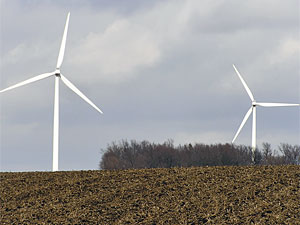Army turns to solar for mission power and more
Submitted by SHNS on Wed, 10/28/2009 - 14:26
By DAVID DANELSKI, The Press-Enterprise
national
ShareThis
The U.S. Army, joining the push to turn Mojave Desert sunshine into electricity, plans to blanket as much as 21 square miles at Fort Irwin with solar mirrors and panels.
Generating solar electricity inside the gates of the Fort Irwin National Training Center near Barstow will allow the military to end its reliance on the potentially uncertain California power grid, Brig. Gen. Robert Abrams said during a recent briefing.
"This is absolute insurance that we will be able to continue our mission to prepare and train forces for deployment," said Abrams, the base commander.
The state power grid could get knocked out by war or terrorism, but the more likely scenarios would be loss of electricity during storms or in blackouts caused by too much demand during hot weather, Fort Irwin spokesman Kenneth Drylie said.
The endeavor is the largest solar energy project within the Defense Department and part of an overall effort to develop secure and alternative energy sources for the military, a defense official said.
Army and Defense Department officials say they will work out long-term leases with two companies to develop solar power at five locations that aren't suitable for training missions on the 1,100-square-mile base. Electricity could begin flowing as early as 2012.
Clark Energy Group of Arlington, Va., and Acciona Solar Power, an affiliate of Acciona SA Corporation in Madrid, plan to produce as much as 500 megawatts of power.
Fort Irwin consumes at most 28 megawatts in the heat of August, Abrams said. The remainder, enough for about 290,000 homes, would be sold to utility companies.
The base, which has a daily population of nearly 23,000 troops, civilians and families, often is the last training stop for soldiers, sailors and Marines before they are deployed to overseas conflicts such as the war zones in Iraq and Afghanistan, Abrams said. The focus is on live-ammunition training with tanks and troops in desert terrain and simulated Middle Eastern communities.
The companies expect to invest $2 billion over 13 years, said Laurence Greene, development director for Acciona Solar Power, which has offices in Henderson, Nev.
To pay for the leases, the solar energy firms would bear the cost of building roads, installing utilities and developing amenities needed at the military training center, said Jerry Hansen, an acting assistant secretary of the Army.
Fort Irwin's territory includes habitat for desert tortoises, a species threatened with extinction. Protecting tortoises is one of the issues that will be examined in environmental reviews that are required before construction can begin. The reviews are expected to take two to three years to complete.
Greene said the first power could be generated by 2012, and all 500 megawatts could be online by 2022.
The developers plan to use a combination of thermal concentration, in which a heated fluid is used to generate steam, and photovoltaic panels, which directly convert sunlight to electricity.
The Fort Irwin solar project is proceeding at the same time state and federal officials are encouraging stepped-up solar and wind development to reduce greenhouse gas emissions and ease the nation's reliance on foreign fuels.
Earlier his month, Interior Secretary Ken Salazar announced the opening of a special renewable-energy office in Palm Springs to swiftly review applications for wind, solar and geothermal projects in territory controlled by the Bureau of Land Management.
(E-mail David Danelski at ddanelski(at)PE.com. For more stories visit scrippsnews.com)
Must credit The Press-Enterprise of Riverside, Calif.
Wednesday, October 28, 2009
Subscribe to:
Post Comments (Atom)



No comments:
Post a Comment